






 |
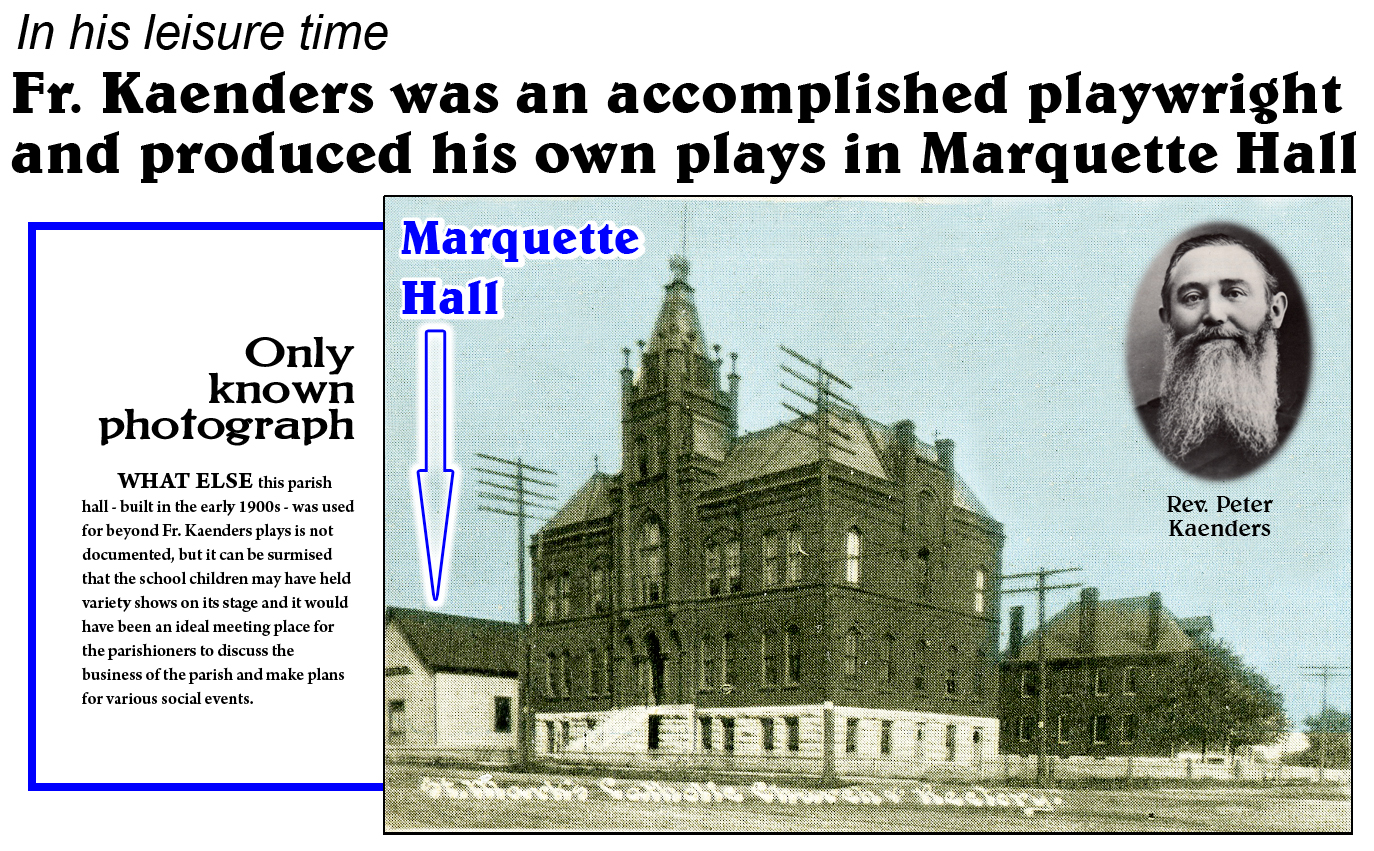

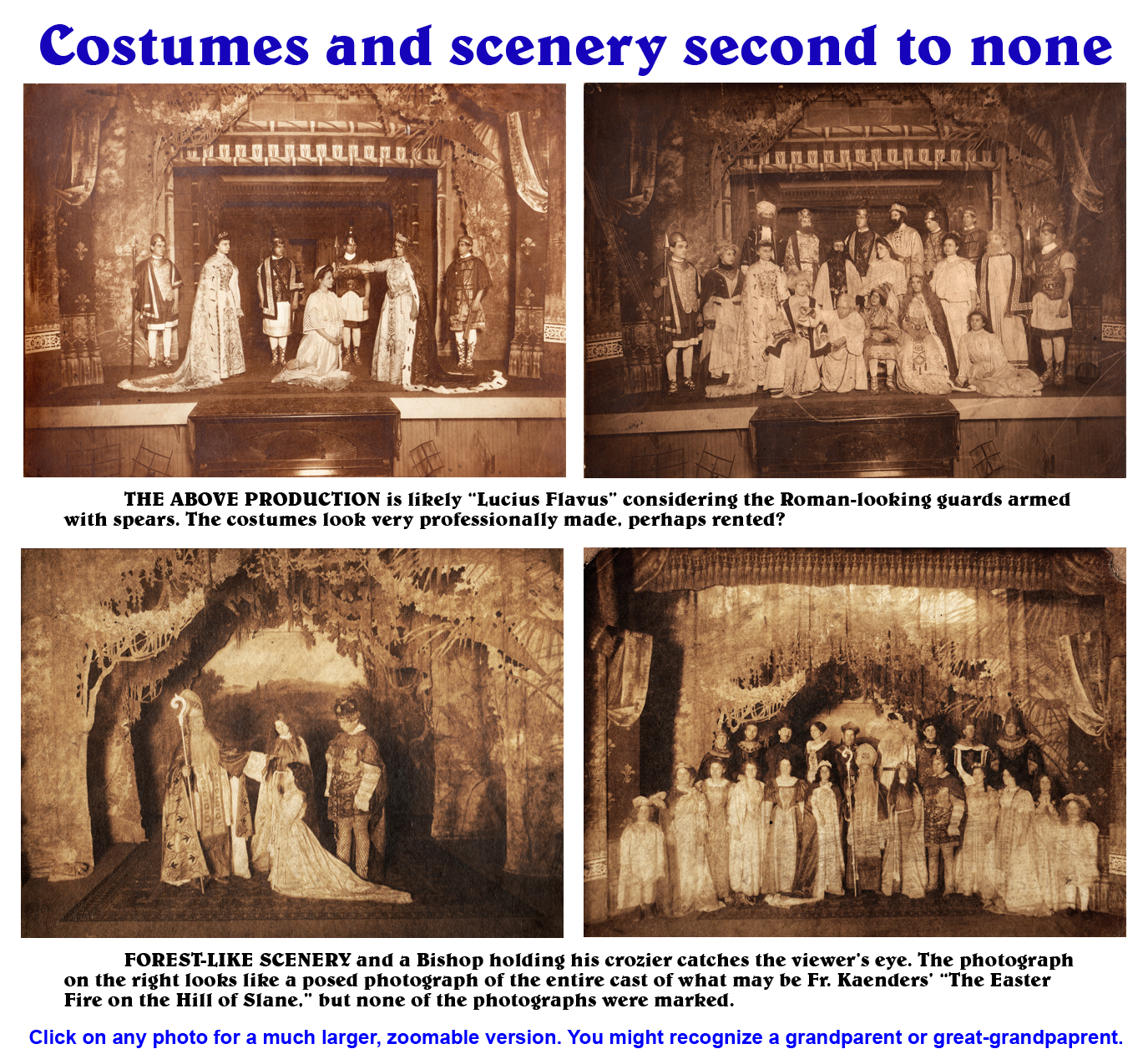

|
|
of Madison County, Illinois and its people 1812-1912 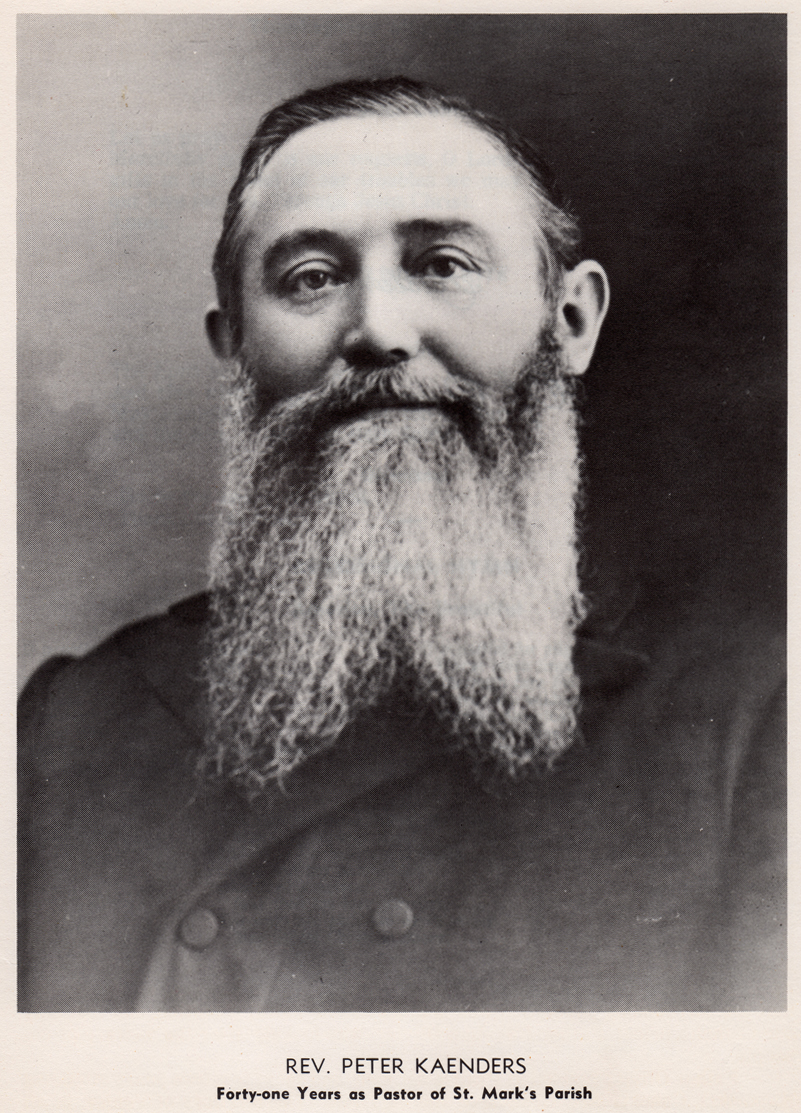 REV. PETER KAENDERS, pastor of St. Mark's Church, at Venice, Illinois, has been an influential factor in the many-sided life of Madison County for thirty-one years. Among his congregation his character and personality have made him a beloved pastor and friend, and citizens of all creeds esteem him for his zealous work and public-spirited attitude towards all movements for the general good.
REV. PETER KAENDERS, pastor of St. Mark's Church, at Venice, Illinois, has been an influential factor in the many-sided life of Madison County for thirty-one years. Among his congregation his character and personality have made him a beloved pastor and friend, and citizens of all creeds esteem him for his zealous work and public-spirited attitude towards all movements for the general good.Father Kaenders was born at Veert, near Geldern. Rhine province. Germany. on September 28, 1856. the youngest of seven children, five of whom were girls and two boys. born to Peter John Kaenders and his good wife, Mary Josepha (Hansen) Kaenders. The subject's brother, Hubert, who owns a farm in his native place. and a sister. now Mrs. Elizabeth Enssen, who owns and resides on the old home place, are with Father Kaenders, the only survivors of the family. The home where Father Kaenders was born is situated in an idyllic spot about one mile from the city of Geldern, on a highway built by the ancient Romans on the river Niers in the shadow of the Castle Haag, which is more than a thousand years old. The highway leads from Geldern to Capellan. Soensbeck and Xanten on the Rhine River. Father Kaenders and the older children of the family received their early education in the schools at Veert. He then attended the college at Geldern until 1873, when, on account of the German Kulturkampf. this school was closed. The call to enter the service of the Landrath and to pursue a military or political course he declined. and desirous to become a priest. he left for America when he was but sixteen years of age and arrived in Hoboken July 5, 1873. He continued his studies in St. Joseph‘s College, Teutopolis, llIinois, where he graduated on June 24, 1875. In the fall of l875 he began his philosophical studies in Ruma, Randolph county. Illinois, where he studied philosophy one year. He followed that with another year's course in philosophy in St. Francis, Milwaukee county, Wisconsin, and his theological studies in St. Francis Seminary of the same place in the year 1880. He was ordained priest by the late Bishop P.J. Baltes in the cathedral at Alton on June 29, 1880. After celebrating his first mass at Kaukauna, Wisconsin, he was appointed assistant at the Cathedral at Alton, after declining to accept the professorship in Philosophy at the seminary where he had completed his studies. On November 20, 1880, he was appointed by Bishop Baltes as rector of Bethalto and Mitchell, with instructions to organize a congregation in Venice. After acquainting himself with conditions, he built the present parsonage at Mitchell. The bishop relieved him his charge at Bethalto, in order that he might be able the better to look after the interests in Venice, and Father Kaenders moved to Mitchell. While in Mitchell he began to organize the congregation at Venice and on August 19, 1881. it was resolved at a meeting of trustees at Venice to proceed at once with the creation of a new church. 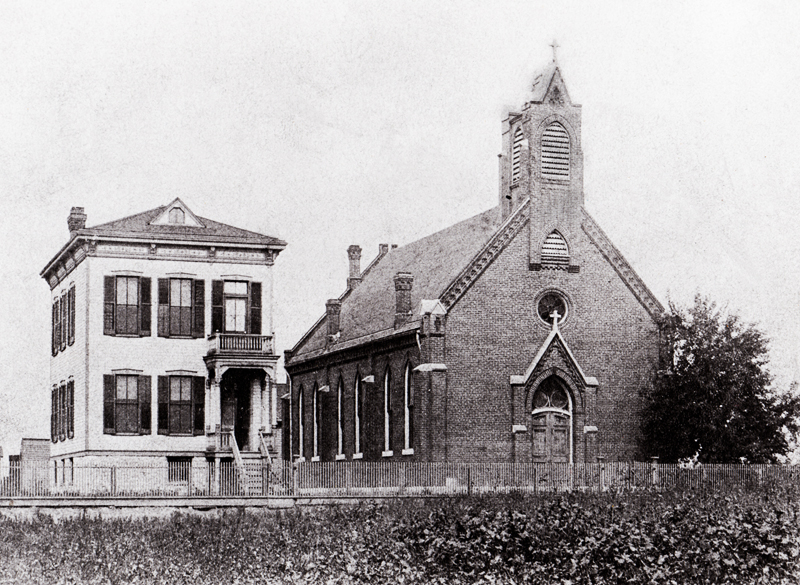 The corner stone of this church, which was called St. Mark's Church, was laid on October 25, 1881. On April 16, 1882, the first service in the new St. Mark's Church by Rev. Kaenders. Subsequently, a parochial school building was erected and afterwards a priest's house.
The corner stone of this church, which was called St. Mark's Church, was laid on October 25, 1881. On April 16, 1882, the first service in the new St. Mark's Church by Rev. Kaenders. Subsequently, a parochial school building was erected and afterwards a priest's house.In June 1885, Father Kaenders moved from Mitchell to Venice and finally it was so arranged that he could devote his entire attention to the Venice church, Mitchell having been provided with another priest. The church, school and parsonage were situated on Granville street, between Second and Third streets. When about the year 1890, the building of the Merchants' Terminal Bridge induced the population to move away from old Venice, Father Kaenders purchased a new site in Block 22, of Knox and Smith‘s second addition to Venice, where he built a substantial brick building for a parochial school. which served at the time for a church and which cost about twelve thousand dollars. In 1903 he moved into his new residence, which was erected at a cost of about six thousand dollars, and in which he still resides. In connection with St. Mark's, he erected the well-known Marquette Hall, which has the best equipped amateur stage in this section. The teachers' residence adjoins Marquette Hall. The first parsonage and school building on Granville were sold, the church building wrecked and the ground sold. When in the spring of 1911 the Evangelical Lutheran Hospital of Granite City failed, Father Kaenders purchased it for fifty-five thousand dollars, and the institution is now managed by Sisters of St. Francis under the name of St. Elizabeth's hospital. Father Kaenders has marvelous linguistic gifts, being well versed in the ancient languages of Latin, Greek and Hebrew; speaking fluently the German, English, French and Dutch and being sufficiently acquainted with the Polish and Slavish languages to be able to attend to the religious wants of these people. 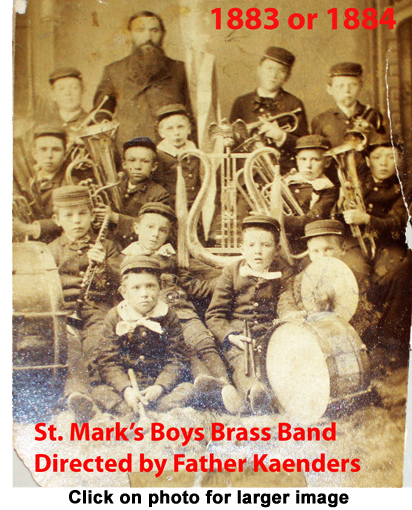 He is also a musician, having been director of an orchestra and juvenile brass band, which he himself instructed. In connection with his parochial school, attended by over two hundred pupils, he personally conducts a commercial class in stenography, typewriting, book-keeping and commercial law.
He is also a musician, having been director of an orchestra and juvenile brass band, which he himself instructed. In connection with his parochial school, attended by over two hundred pupils, he personally conducts a commercial class in stenography, typewriting, book-keeping and commercial law.In his leisure hours, for even a busy man has some, he has written dramas, one of which, entitled “The Easter Fire on the Hill of Slane,” was given in the Century Theatre in St. Louis with great success in 1906. An appreciation of the same given by the Censor of St. Louis on May 31, 1906, follows: “ 'The Easter Fire on the Hill of Slane,' is in three acts and is the work of Rev. P. Kaenders. There is much that is praiseworthy in the new piece. The story of the play is told in sweet simplicity; its sentiment is lofty; its dialogue excellent; its action undemonstrative; and its heart appeal unusually strong.” The following dramas from the pen of Father Kaenders have been printed: "The Prince of Fez," "The Easter Fire on the Hill of Slane," "Lucius Flavus," "Lorna Doone," a dramatization of Blackmore's novel, and the "Maid of Desenzano." Two are still in manuscript, the "Wizard of Antioch" and "Mary O'Murrough," a dramatization of Rosa Mulholland's story. Father Kaenders is a great traveler and has made extensive trips in this country and also in Europe. In 1901 he visited the present Pope Pius X, when he was still Patriarch of Venice. The impressions received by him on his tours through Italy, Switzerland, Austria, Bavaria, Baden, France, Germany, Belgium, Holland, England and Ireland appeared in a series of articles in the Edwardsville Intelligencer and other papers of Madison County. He has given lectures on the masterpieces of painting and sculpture seen by himself in the various galleries of Europe and has been frequently called upon to give illustrated lectures on places of Interest visited by him. It would be indeed a difficult task to find a man of greater culture and versatility. He has given to the parish a wondrous success, but it has by no means been an easy task. He has overcome many obstacles and had many unusual experiences, some of them unpleasant, for instance going through several high-waters, when he was compelled to confine himself to the second story of his residence for several months each time, surrounded by water ten feet deep. He has served all his time in the priesthood, from 1880 to the present (thirty-one years), in Madison county and nothing could be deeper than his interest and affection for it and its people.  In October 1911, Rev. William Wozniak was sent as an assistant to St. Mark’s parish, and was instructed to look after the needs of the Polish members of the Church, and eventually to organize a Polish parish in Madison, where most of these people lived. Father Wozniak was able to establish the new parish within a year. Consequently, in 1912 the new parish of St. Mary’s was formed in Madison. The people erected a modest, frame building for church and school purposes, and on December 20, 1912, Father Wozniak took charge of the newly formed parish, which was the second branch of the St. Mark’s parish. About the year 1912, St. Mark’s parish entered upon a period of decline due to various causes and circumstances. In the course of its life, the parish had been visited by three floods - 1883, 1892 and 1903 - all more or less destructive. Destruction, poverty, depression, sickness and disease resulted from the floods. Malaria, typhoid and smallpox played havoc in this community as a result of the high waters. Then, too, St. Mark’s had seen its numbers diminished twice by the formation of new parishes of St. Joseph in Granite City in 1901 and St. Mary in Madison in 1912. This fact decreased not only its membership but also its source of revenue. Another severe blow to St. Mark’s was the withdrawal of the venerable school Sisters. Three different religious communities had been in charge of St. Mark’s School from 1884 to 1910; all left more or less on account of the unhealthful climatic conditions of this section during those high water days. But Father Kaenders weathered all storms and always succeeded in maintaining his school by means of lay teachers, who made heroic efforts to keep up the high standard of discipline set by the venerable Sisters.  In 1911, Father Kaenders, at the suggestion of and with permission of Bishop
Ryan, purchased the bankrupt Evangelical Lutheran Hospital, in Granite City,
Illinois, for the purpose of converting it into a Catholic hospital under the
direction of a community of hospital Sisters. This was evidently a move in the
right direction. A good Catholic hospital was needed in the Tri-Cities.
In 1911, Father Kaenders, at the suggestion of and with permission of Bishop
Ryan, purchased the bankrupt Evangelical Lutheran Hospital, in Granite City,
Illinois, for the purpose of converting it into a Catholic hospital under the
direction of a community of hospital Sisters. This was evidently a move in the
right direction. A good Catholic hospital was needed in the Tri-Cities.But in the interval, 1911 to 1921, Father Kaenders encumbered great difficulties in the operation of the hospital, and only the heroic and noble sacrifices of his parishioners in Venice and Madison and new friends in Granite City, averted the threatened disaster of certain bankruptcy. This added burden of conducting a hospital in a neighboring city two miles distant from his own parish church was a super-human task for Father Kaenders, and had ill effects both to himself and to his flock. This new burden weakened all the more the already declining parish; for it drew on the revenue of the parish from which many families had already removed, resulting in a noticeable depre- ciation of parish property. Worry and anxiety soon undermined the health of Father Kaenders to such an extent that he never fully recovered. At this period of the parish, Father Kaenders was assisted by Rev. William Goesse, S.J., of St. Louis, Mo., and from October 1918, to April 1920, by Rev. Charles Schaeffer, of the Archdiocese of St. Louis, a very learned, holy and zealous priest, but who was also in ill health. His burning zeal and profound piety made a lasting impression on the parish. Failing health soon cut short his work in Venice, and he betook himself to St. Louis, where he died in 1920. In April, 1920, Father Schaeffer was succeeded by Rev. Walter Speeman, whose energy and determination soon made themselves felt in the parish. His stay was brief, however, for on March 1, 1921, he was promoted to the joint pastorate of Saints Alphonsus and Michael parishes at Brighton and Belltrees, respectively. In January, 1921, the hospital now known as St. Elizabeth’s, in Granite City, was sold by Father Kaenders to the Sisters of Divine Providence, Pittsburgh, Pa., who took immediate charge of it, and since have conducted it very successfully. Father Kaenders was thus relieved of one of his burdens, but the strain of the past ten years had impaired his health to such a degree that not only his health but his life also was at stake. 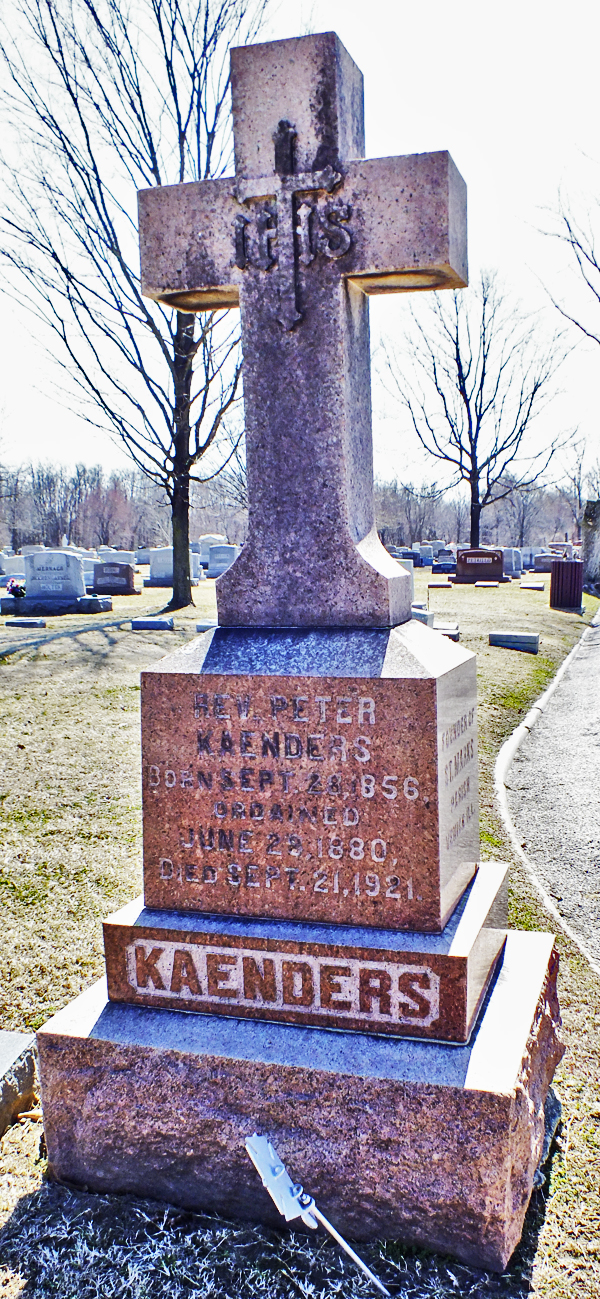 St Mark’s Parish was badly disorganized by reason of widespread dissension
and lack of co-operation. There was much work to be done. Father Kaenders
yearned to continue his labors among his flock, but his strength was already
exhausted. Realizing his condition, Father Kaenders, on March 1, 1921, with permission of the Bishop, retired from active service and betook himself to St.
Elizabeth’s Hospital, hoping to regain his shattered health. He died one week before his sixty-fifth birthday.
St Mark’s Parish was badly disorganized by reason of widespread dissension
and lack of co-operation. There was much work to be done. Father Kaenders
yearned to continue his labors among his flock, but his strength was already
exhausted. Realizing his condition, Father Kaenders, on March 1, 1921, with permission of the Bishop, retired from active service and betook himself to St.
Elizabeth’s Hospital, hoping to regain his shattered health. He died one week before his sixty-fifth birthday.All the medical skill and the tender nursing of the devoted Sisters were of no avail. On September 21, 1921, Father Kaenders fortified with all the comforts of religion, passed away to his eternal reward, thus bringing to an end his forty-one years of service to his people. Funeral services for Father Kaenders were held in St. Mark’s Church September 27. A large concourse of priests and people filled the church. the Very Rev. Dean Joseph Meckel, Alton, sang the Requiem High Mass. Rev. F. A. Marks, Collinsville, and Rev. F. Holweck, St. Louis, were deacon and subdeacon, respectively. The Very Rev. E. L. Spaulding, Vicar General, Alton, delivered the funeral sermon. The remains of Father Kaenders rest in Calvary Cemetery, where his grateful people have erected a suitable monument to his memory. (Click on any photo for a larger image) 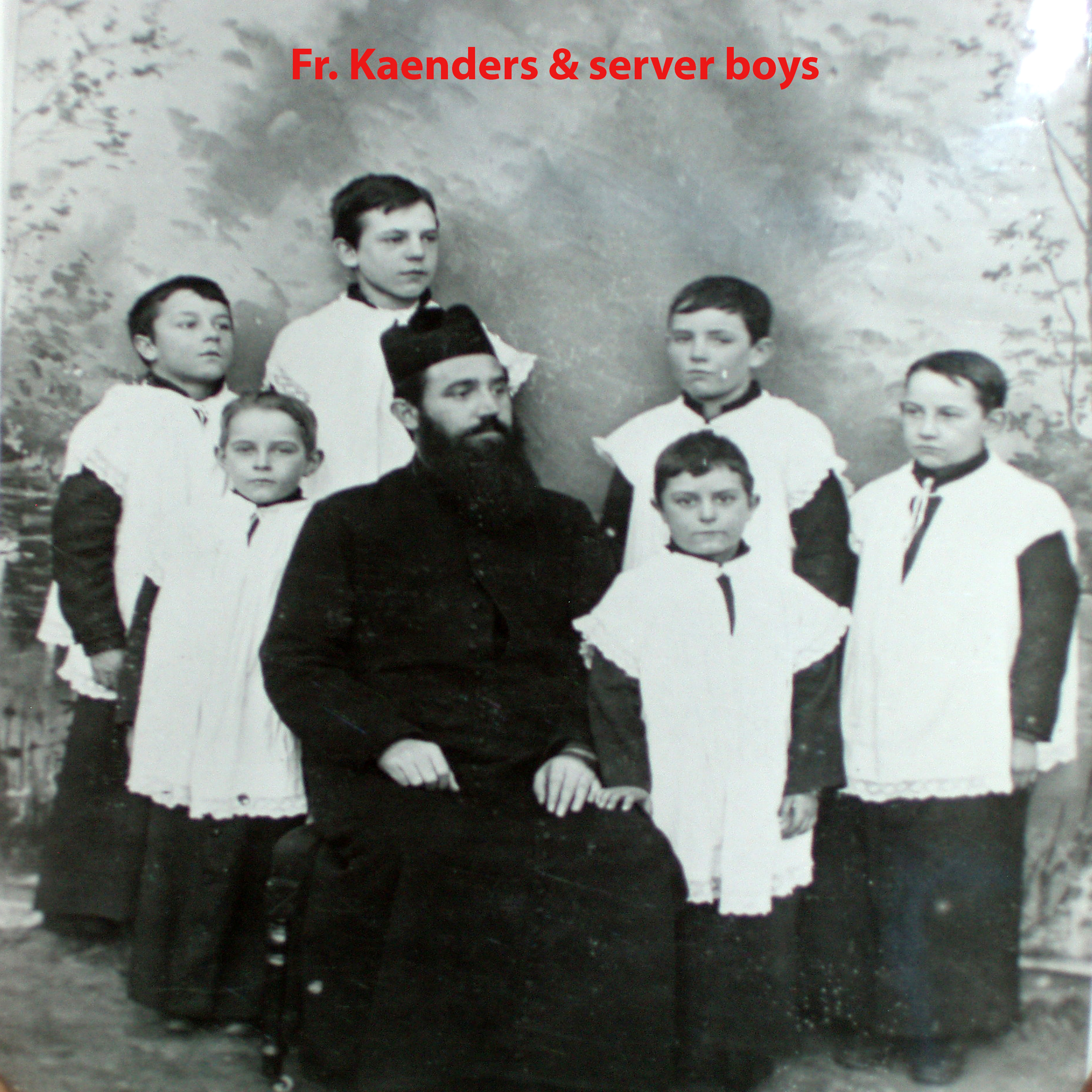

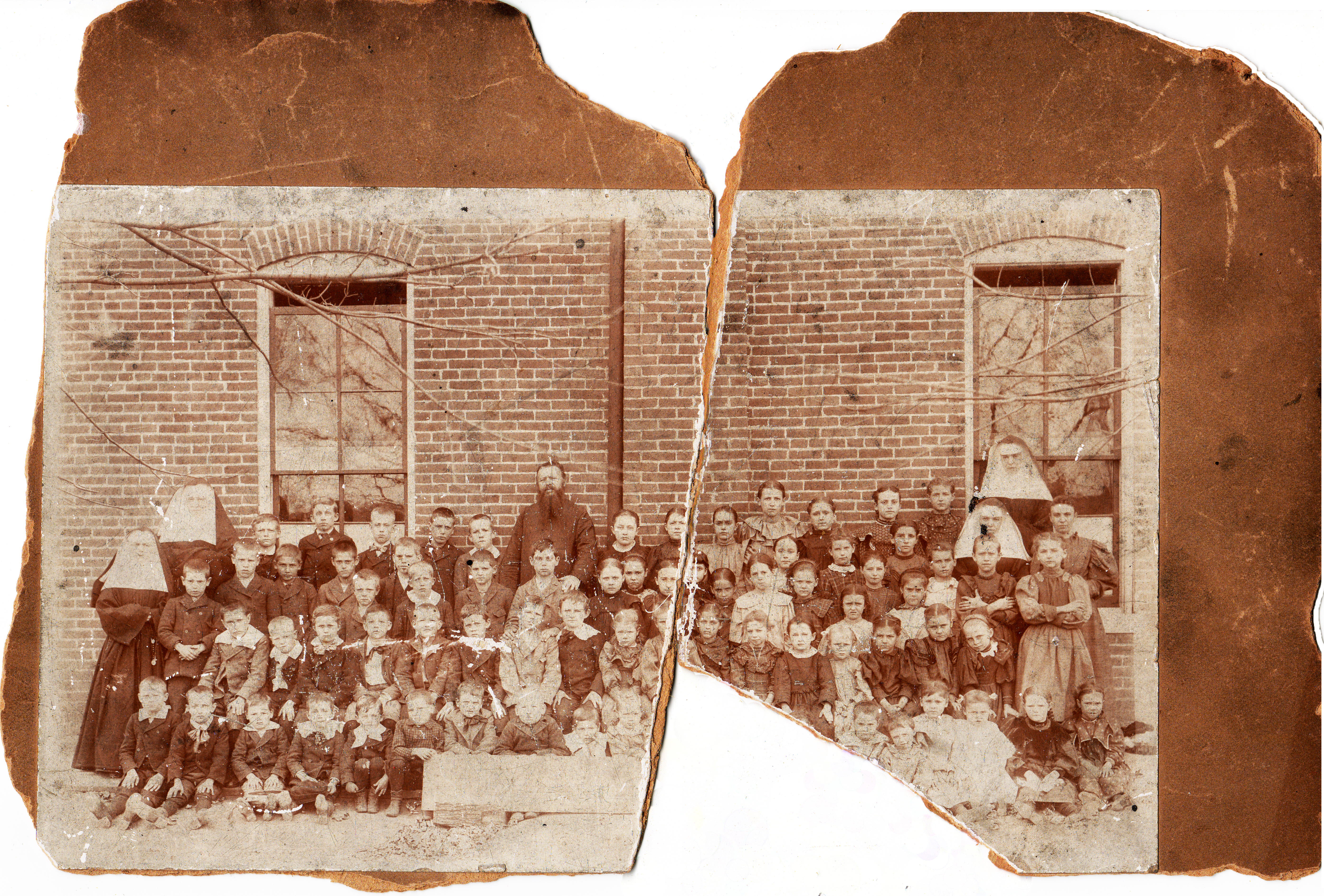
Father Kaenders, Sisters of the Precious Blood and Venice children pose for a photo at what may be the original school building on Granville Street. This photo is believed to have been taken between 1884 and 1891. |
